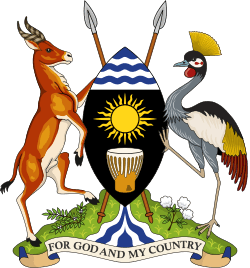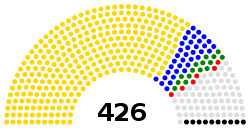Parliament of Uganda
| Parliament of Uganda | |
|---|---|
| 10th Parliament | |
 | |
| Type | |
| Type | |
| Structure | |
| Seats | 426 |
 | |
Political groups |
Government (293) Opposition (57) Others
|
| Elections | |
Last election | 18 February 2016 |
| Meeting place | |
|
| |
| Parliament Avenue, Kampala | |
| Website | |
|
www | |
 |
| This article is part of a series on the politics and government of Uganda |
|
Judiciary |
|
| Foreign relations |
The unicameral Parliament of Uganda is the country's legislative body.
Overview
The most significant of the institution's functions, is to pass laws which will provide good governance in the country. The government ministers are bound to answer to the people's representatives on the floor of the house.Through the various parliamentary committees, parliament scrutinises government programmes, particularly as outlined in the State of the Nation Address by the President. The fiscal issues of the government, such as, taxation and loans need the sanction of the parliament, after appropriate debate.[1]
Composition
The Ugandan parliament is composed of 238 Constituency Representatives, 112 District Woman Representatives, 10 Uganda People's Defence Forces Representatives, 5 Representatives of the Youth, 5 Representatives of Persons with Disabilities, 5 Representatives of Workers, and 13 ex officio Members.[2]
History
The Ugandan Parliament was established in 1962, soon after the country's independence.[3]
First Parliament (1962–1963)
This body was then known as the Legislative Council (LEGCO). It had 92 members and was presided over, as Speaker, by Sir John Bowes Griffin, a British lawyer and former Ugandan Chief Justice.
Second Parliament (1963–1971)
During this period, Prime Minister Milton Obote abrogated the constitution and declared himself President of Uganda in 1966. This parliament also witnessed the abolition of Uganda's traditional kingdoms and the declaration of Uganda as a republic. The Speaker during the Second Parliament was Narendra M. Patel, a Ugandan of Indian descent. This Parliament ended when Idi Amin overthrew Milton Obote's government in January 1971.
Third Parliament (1979–1980)
Following the overthrow of Idi Amin in April 1979, a new legislative body known as the Uganda Legislative Council was established. With an initial membership of 30, the membership was later increased to 120. This was the Third Parliament and was chaired by Professor Edward Rugumayo. This legislative body continued to function until the general elections of December 1980.
Fourth Parliament (1980–1985)
This period marked the return to power of Milton Obote and the Uganda People's Congress (UPC), following the disputed national elections of 1980. The Speaker of the Fourth Parliament was Francis Butagira, a Harvard-trained lawyer. the Fourth Parliament ended when, General Bazillio Okello overthrew Obote and the UPC government in 1985.
Fifth Parliament (1986–1996)
Known as the National Resistance Council (NRC), the Fifth Parliament was established following the end of the Ugandan 1981-1985 guerrilla war. Starting with 38 historical members of the National Resistance Movement and National Resistance Army, the legislative body was gradually expanded to include representatives from around the country. The Speaker during the Fifth Parliament was Yoweri Museveni, who also concurrently served as the President of Uganda.
Sixth Parliament (1996–2001)
The Sixth Parliament was constituted during one-party rule (NRM). James Wapakhabulo served as Speaker from 1996 until 1998. From 1998 until 2001, Francis Ayume, a member of Parliament from Koboko District, served as Speaker.
Seventh Parliament (2001–2006)
The Seventh Parliament was presided over as Speaker by Edward Ssekandi. The most controversial legislation passed during this period was the amendment of the Constitution to remove presidential term limits.
Eighth Parliament (2006–2011)
This was a continuation of the Seventh Parliament, with Edward Ssekandi as Speaker and Rebecca Kadaga as Deputy Speaker.
Ninth Parliament (2011–2016)
The Ninth Parliament is presided over by Rebecca Kadaga as Speaker, and Jacob Oulanyah as Deputy Speaker.
Tenth Parliament (2016–present)
In the Tenth Parliament, Rebecca Kadaga and Jacob Oulanyah remained in their posts as Speaker and Deputy Speaker respectively.
| Parties | Constituency seats |
District woman reps. |
Indirect seats |
Total seats | ||
|---|---|---|---|---|---|---|
| National Resistance Movement | 164 | 86 | 13 | 263 | ||
| Forum for Democratic Change | 23 | 11 | — | 34 | ||
| Democratic Party | 11 | 1 | — | 12 | ||
| Uganda People's Congress | 7 | 3 | — | 10 | ||
| Conservative Party | 1 | — | — | 1 | ||
| Justice Forum | 1 | — | — | 1 | ||
| Independents | 30 | 11 | 2 | 43 | ||
| Uganda People's Defence Force Representatives | 10 | 10 | ||||
| Vacant | 1 | 1 | ||||
| Total (turnout %) | 238 | 112 | 25 | 375 | ||
| Source: Electoral Commission of Uganda, African Elections Database | ||||||
|
Note on the Distribution of seats: | ||||||
| Parties | Votes | % | Constituency seats |
District woman reps. |
Indirect seats |
Total seats |
|---|---|---|---|---|---|---|
| National Resistance Movement | 142 | 49 | 14 | 205 | ||
| Forum for Democratic Change | 27 | 10 | - | 37 | ||
| Uganda People's Congress | 9 | - | - | 9 | ||
| Democratic Party | 8 | - | - | 8 | ||
| Conservative Party | 1 | - | - | 1 | ||
| Justice Forum | 1 | - | - | 1 | ||
| Independents | 26 | 10 | 1 | 37 | ||
| Vacant | 1 | - | - | 1 | ||
| Uganda People's Defence Force Representatives | 10 | |||||
| Ex-officio members | 10 | |||||
| Total (turnout 72 %) | 215 | 69 | 15 | 319 | ||
| Source: Inter-Parliamentary Union | ||||||
|
Note on the Distribution of seats: | ||||||